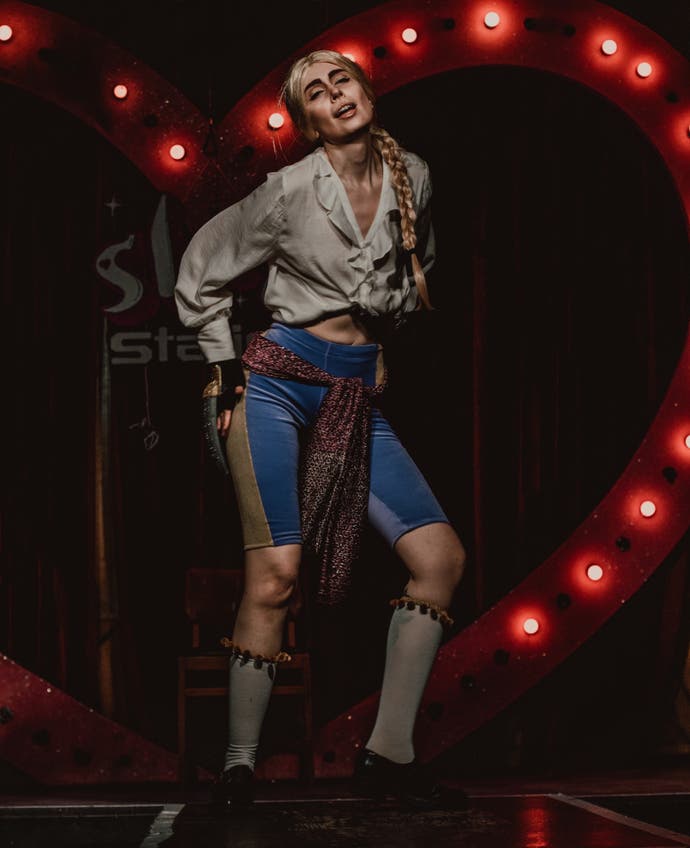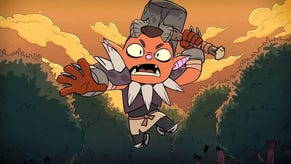How a new generation of drag artists is breaking limits and queering video games
Mommy Kratos, meet Hot Piranha Plant.
Hello! Eurogamer is once again marking Pride with another week of features celebrating the intersection of queer culture and gaming in all its guises. Things get underway today as James Croft examines how a new generation of drag performers is combining its art and a deep love of video games to explore and reimagine what bolder, queerer gaming could be.
I was a gamer before I knew I was gay. I started gaming in 1989, at six years old, when my parents brought home an Amiga 500. A boxy, beige monstrosity with a chunky keyboard and a polygonal mouse, the Amiga, an early home computer, wasn't much of a looker. But, to me, it was a portal to other worlds. I spent hours as a child watching my father battle his way through the ThunderCats side-scrolling platformer – I can still hear the crunchy "swoosh" of Lion-O's sword and the rising chirp of his jump – and looking over my mother's shoulder as she stalked the corridors of Dungeon Master, hiding when I heard the shuffle of the mummies. And I spent hours trying to complete Barbarian, an early fighting game which saw two loin-clothed muscle-men roll and kick and hack each other to death.
I'd love to say Barbarian made me gay, that those tight thighs and pixel biceps sparked something queer in me – but my gay awakening came 20 years later. As a teen and young adult, I experienced gaming as a resolutely straight hobby: romance, if there was any, was always heteronormative; gender stereotypes were rigidly enforced; and there was no sex in games hardly ever. Gaming was not queer. Now, however, gaming has exploded from a niche hobby to a global obsession, and a new generation of fans is queering games in ways my younger self could never imagine, using drag as a medium to explore, examine, and expand gaming culture.
Fulfilling Bayonetta's queer potential
To get an insight into this new world, I spoke with Velvet Caveat (creator of SlayStation, a London "drag video game cabaret" dedicated to the mash-up of gaming and drag) who helped me understand the three main ways game characters can be presented in the medium of drag. First, you can select a character which already has queer traits. Bayonetta is a prime example: she's unusually tall for a woman, is sex positive and kinky, and tends to be presented as a strong protagonist who frequently rescues male sidekick and himbo Luka, overturning the trite "damsel in distress" trope. This makes Bayonetta a prime candidate for a drag performance, because her character already challenges rigid norms of sexuality and gender. Bayonetta hardly needs queering, because she's queer af already – she has guns on her high heels!
So, when Velvet Caveat takes to the stage as a picture-perfect Bayonetta, wielding the character's iconic dual pistols and dancing to Charli XCX's "Baby" with moves which could be drawn directly from the game, it feels like the character was made for drag. Velvet Caveat's Bayonetta is a glorious revelation of the queerness already inherent in one of gaming's most beloved characters, instantly iconic. But it's also more than that. By exploring the character of Bayonetta through the medium of drag, Velvet and her fellow SlayStation artists are expanding the creative possibilities within gaming culture. "With SlayStation," Velvet told me, "we're giving people a medium they love, while fleshing it out in ways that the medium itself will never do. When we offer a queer take on their favourite characters, we are giving people a dose of something they wish was reality, that would make gaming even better."

I think she's right: mainstream games, after all, despite being increasingly marketed toward adults, include very little exploration of sex and sexuality. Yet sexuality is a major component of the human experience, something people want to explore – so fans take up the slack. Projects like SlayStation empower players by showing them an angle on gaming culture they would otherwise miss, because mass-market games could never present some of the raunchy, lewd, or transgressive ideas which drag revels in. On the SlayStation stage, characters that have queer traits in games can take on their full queerness, freed from the limitations of their source medium. Bayonetta can be her true self.
Plants can be sexy too
Susan Sontag, in her epochal essay Notes on "Camp", wrote that camp "is the love of the exaggerated, the 'off', of things-being-what-they-are-not." This perfectly describes the second, more offbeat approach to queering video game characters: selecting something absurd or random, and pushing it to an extreme. Consider the iconic Piranha Plant, an enemy from the Mario games which is simply a stalk with a chomping red flower. It has no gender and no sexuality, it is simply a hazard to be avoided. It is hardly a character at all.
Yet in hands of Mary O'Kart (a Brighton-based queen whose drag persona is deeply informed by gaming culture) and her costumier Cute As Clothing, the Piranha Plant becomes a joyous dragsona. Mary explained to me how she is not trying to recreate a character exactly as it is in the game, but rather to use the character as a springboard to create something that feels at home in the world of drag – a "drag evolution", if you will. Mary O'Kart's Piranha Plant absolutely nails it: she emerges from a slinky green pipe to reveal green briefs and a red polka dot top, jagged white teeth on the neckline. It is immediately recognisable to those who love Mario, and unmistakably drag – an over-the-top fusion of two cultures which manages to make a carnivorous plant sexy, bringing Sontag's definition of camp to life.
It was its very over-the-topness, in fact, which drew Mary O'Kart to the world of Mario when she was choosing her drag name. "In the world of Mario there are countless inspirations," she told me. "That world is so rich in colour and character – you can pull something even from the smallest Goomba." When it came to the Piranha Plant, Mary started with the teeth, playing with different ways of incorporating the chomping flower into an outfit. She first tried a much more literal interpretation of the character, with a stalk for a dress and the toothed flower as a hat, but felt that wasn't "drag" enough. What would make it drag? "Amping it up. Making it bigger. Giving it a twist." It wasn't a drag look, in Mary's mind, until it was a big look.

That bigness has, for Mary, a personal component: it's a representation of how queer people, so long marginalised, are stepping out onto life's stage. "Drag is such a huge celebration of being queer," she explained, "and there's nothing queer people love more than stepping into the light. We spent too long hiding in closets, so let's explode out of it! If I can do that and twist it with video games, even better!" The resulting look does just that.
Yes Mummy Kratos!
The third and final approach is to take a character who seems to embody or reinforce gender and sexual norms, and subvert them. Kratos from the God of War series is, in many ways, a stereotypical action hero. He's muscle-bound, bald, and bearded; utterly emotionally constipated; and solves all his problems through extreme violence. Yet Miss Terri Boxx, a bearded queen (a drag artist who dresses as a woman but still wears a full, fantastic beard) serves up a delicious femme Kratos which turns our expectations on their head.
The idea came to Terri when she was considering options for a drag night with a "femme fatale" theme. "There are so many femme characters that I could do," she thought, "but wouldn't it be fun to take a hyper-masculine character and put them in drag?" The gender-fuckery here is exquisite: Boxx embodies a hyper-masculine video game character, wielding a massive runed axe, wearing a feminised version of his signature armour, sporting a lustrous wig, alongside an impressive beard. This both is and is not the Kratos we know. The choice of backing track is the cherry on the cake. Boxx performs her routine to Boys by Lizzo, which both references and reframes the way Kratos gruffly admonishes his son in the most recent God of War games.

"I like big boys, itty bitty boys, Mississippi boys, inner city boys/I like the pretty boys with the bow tie/Get your nails did, let it blow dry", Lizzo sings in a joyous celebration of all different types of manhood. Kratos, by contrast, is extremely gender normative, and is even (in the most recent games) raising his son to embody some of his more toxic traits. Mashing Lizzo's expansive idea of masculinity against Kratos' more rigid one helps us understand Kratos' character better, while pointing to ways in which it could be different. This is an expression of Terri's whole approach to drag as an art form: "For me, drag is all about breaking gender norms and showing things from a new perspective." With her Kratos, she succeeds.
Who braids Vega's hair?
These approaches overlap, of course, because some video game characters have contradictory traits. Street Fighter's Vega is a stunningly ripped man trained as a Matador (a notoriously macho profession in Spain), who is canonically obsessed with beautiful female characters. Yet his tight costumes, flamboyant style, and obsession with physical beauty read to many players as gay. This complexity is ripe for subversion.
Enter Loose Willis, a drag king whose Vega is pure genius. Willis, inspired by Vega's post-fight quotes, in which he celebrates his own beauty while disparaging other characters' looks, imagined what his pre-fight preparation might look like. "He's here to fight," Willis reasoned, "but obviously Vega must have a five-hour long, Patrick Bateman-style skincare routine. He's not going to fight unless he is perfect." That routine became the act, a sort of reverse strip tease as Vega prepares for battle: Willis starts in just a pink robe and knickers, and we watch as he shaves his legs with bejewelled claws, before donning his trademark tights and blouse.

The performance is so much fun, but it has a deeper purpose: Willis wants to reclaim masculinity by presenting it as "a wonderful hodgepodge which makes people happy and secure in their own gender." His goal is to "show that masculinity is for men and women and nonbinary people," so portraying Vega – a character which has such a layered and complex gender presentation – makes perfect sense. It clearly strikes a chord: at the end of the act, when Willis, fully-dressed, looks into a mirror and quotes one of Vega's lines from the game – "Does your ugliness embarrass you?" – the crowd goes wild with appreciation.
To queer games, you must love games
All these drag artists have found that audiences love their video-game-inspired looks, and it's easy to understand why: all four performers share an infectious love of games and gaming culture. These are not dilettantes, playing off the popularity of video games to score quick internet points. Rather, they are connoisseurs, who adore both drag and games, and who have found a way to bring their passions together. After all, to queer a character, you have to know that character well. As Mary O'Kart puts it, "Knowing games well is the most important thing. I can't have a name like Mary O'Kart and be shit at the game – I'm fucking great at it! – or not know the references."
And these queens and kings know the references. Mary O'Kart, when designing her upcoming tribute to Mario Kart's Rainbow Road, is including easily-missed details like the Mario-themed fireworks which explode in the background of the stage. Miss Terri Box's performance as GLaDOS from Portal uses actual lines from the game mixed into the backing track. Loose Willis' costume for portraying Vamp from Metal Gear Solid includes a custom dog tag reading "Vamp – Chaotic Bisexual", a reference to the character's canonical bisexuality.
Velvet Caveat recently brought the house down with an inspired drag stand-up set in which she became Patricia the Sand Seal, a relatively obscure character from The Legend of Zelda: Breath of the Wild and Tears of the Kingdom. During the routine, Velvet imagined the debates around trans rights within Gerudo Town, a community which does not allow males to enter – a topic close to her heart as a proud trans performer. The image of holding a sign reading "Trans Women Are Women!" shows how deep knowledge of games, combined with a fierce drag aesthetic, can make a political point in a fun and engaging way.
It might seem ironic that some of the most hardcore gamers I've ever met have been the ones most dedicated to queering the medium. Mainstream gaming culture is, after all, notoriously closed to expanding representation, and is sometimes aggressively unwelcoming towards women, people of colour, and LGBTQIA+ folk. Miss Terri Boxx experienced this when an image of her gender-bending drag version of Lilith from the recent Diablo 4 was shared by the official Diablo Instagram account: within the first half-hour hateful comments were pouring in. Some fans were enraged that a literal demon was being portrayed by a Black person in a drag outfit.
Despite the gatekeeping, though, these drag artists point the way to a more vibrant future both for drag and for gaming. After all, why should a demon look like any human gender? A world in which a demonic character like Lilith was more surprising in terms of their gender presentation would be a more interesting world for gamers too. Terri says, "Drag is a no-limit art form, and it's beautiful because of that", and gaming has that potential too – if it is willing to break out of some of the boxes it's currently trapped inside.
When drag is under attack, these gamers fight back
The queer joy of these drag artists is especially important at a time when drag is under attack. In both the UK and the USA, right-wing extremists are targeting drag as part of an all-out assault on the trans community. In June of 2023 alone, masked men were caught on camera Sieg Heiling outside a drag story hour in New Hampshire, while at a pub in London members of the far right violently attacked those present to support Drag Queen Story Hour.
These sorts of scenes are only becoming more common. All the kings and queens I spoke with were nervous about this attack on their beloved art form. Loose Willis told me that "the language now is so violent, so homophobic and transphobic", that he is worried about the potential for violence at his shows. I hate that. Their work, though, gives me hope. By creating explicitly queer versions of gaming characters, these artists are creating a home for LGBTQIA+ gamers like me. Loose Willis, at his very first SlayStation, had decided to portray Father Gascoigne, a boss from Bloodborne. He was worried the audience wouldn't recognise this less well-known character: "Is anyone gonna know who this is?" But the audience knew, and loved it. "They were so excited," Willis said, "and I knew I was in the right place. I've found my people!" Amid Mommy Kratos and hot Piranha Plant, I think I've found mine too.
All the performers featured in this article have upcoming performances you are invited to! Mary O'Kart will be performing in the Legends Brighton cabaret tent at this year's Brighton Pride. Velvet Caveat, Loose Willis, and Miss Terri Boxx can all be caught at SlayStation's upcoming The Crystal Ball event on 5th August at the Clapham Grand, celebrating the Final Fantasy series.




.jpg?width=291&height=164&fit=crop&quality=80&format=jpg&auto=webp)

_Rwmp6uD.jpg?width=291&height=164&fit=crop&quality=80&format=jpg&auto=webp)


